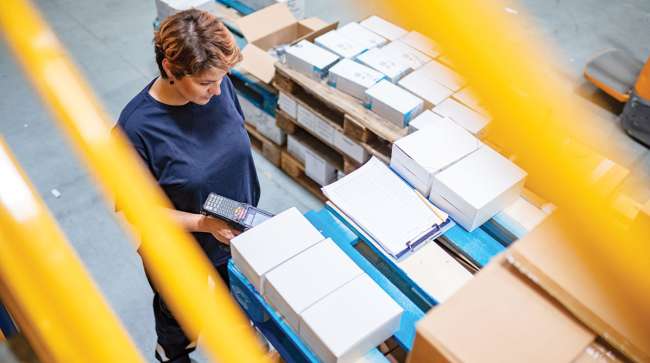Staff Reporter
Efficiency Gains Arise From COVID-Induced Contactless Delivery

[Stay on top of transportation news: Get TTNews in your inbox.]
COVID-19 has driven the need for contactless delivery methods, but a silver lining may be increased efficiency.
The Consumer Brands Association launched a task force early on in the pandemic to work with retailers, manufacturers and carriers to test and create contactless standards. It is now in the final stages of creating a report detailing standards for methods and procedures.
“The task forces put emphasis on documenting the underlying use cases, understanding current processes, talking about what the technology would enable going forward and then laying out the standards and publishing that,” Tom Madrecki, vice president of supply chain at the Consumer Brands Association, told Transport Topics. “This is where we think that contactless delivery is headed.”

Madrecki
Madrecki added there was a series of discovery and discussion calls among the companies that were involved. There also were a dozen pilot programs in which companies were testing methods.
“I think at the start of the pandemic, contactless pickup and delivery was really for the sake of social distancing and keeping drivers physically distant from warehouse employees, shipping clerks and guards,” Will Chu, co-founder of logistics software provider Vector, told TT. “There’s a lot of traffic, a lot of people moving in and out, and you think about distribution facilities and the number of people coming in, definitely hot spots for potential outbreaks.”
XPO Logistics enhanced its contactless delivery capability Aug. 5 with synchronized e-signature capture on hand-held devices. Ryder System Inc. has worked to implement contactless interaction with customers. Coyote Logistics has been assisting with the task force.
XPO ranks No. 3 on the Transport Topics Top 100 list of the largest for-hire carriers in North America and No. 1 on the TT Logistics 50. Ryder Supply Chain Solutions is No. 10 on the for-hire TT100.

Shroeger
“Contactless and electronic supply chains have been a growing necessity in the industry for many years, but the pandemic has accelerated the need to innovate and adapt quickly,” Nick Shroeger, chief network solutions officer at Coyote Logistics, told TT. “While many of the recent advancements in contactless technology have been rooted in creating safer operations and working conditions for members of the supply chain, there are additional benefits to these solutions.”
Shroeger added that benefits have included efficiency gains and cost savings tied to decreased dwell times, automatic paperwork and data storage, and delivery in full reconciliation. He believes these are reasons for recent advancements to stay long term.
“There’s a lot of success, not only around keeping workers safe, which is the original premise, of course, and trying to minimize interaction,” Madrecki said. “But there’s actually a lot of documented cases of enhanced efficiency when it comes to the speed that a driver can get in and get out.”

Chu
Chu noted by using technology to go to a paperless system, a lot of time is saved. It is eliminating lines to get into facilities and eliminating traveling from a staging area to check in with a clerk. The facilities also are getting more visibility into what is happening.
“We’ve been able to reduce dwell times from 30% to 50%,” Chu said. “We’re replacing a process that really involved a driver speaking to multiple people, getting in and out of their cab multiple times to get paperwork, to sign paperwork. They’re moving into a process where everything can be done from the comfort of their own cab, over a mobile app.”
Chu also believes that many of these contactless methods, because of the benefits, are here to stay.

Fleets are investing in tech-based safety tools that inform and forewarn potential risk. But how do they condition and prepare drivers to respond to safety alerts? Find out as the RoadSigns Team speaks with Tom DiSalvi, VP of safety at Schneider National, and Charlie Mohn, director of product innovation at Drivewyze. Hear a snippet, above, and get the full program by going to RoadSigns.TTNews.com.
“The conversation has shifted from safety and social distancing to efficiency and visibility,” Chu said. “That has been the larger driver of process and business process change. You’re moving from a system where it was just a physical piece of paper to now a digital system.”
Madrecki noted that to mitigate the pandemic’s effects companies were quick to adopt shorter-term fixes such as social distancing and having drivers signal to dockworkers through the cab instead of going up to someone.
But creating standards for a truly contactless system has involved such things as moving toward paperless technology.
“The open question is, how do you scale new technology,” Madrecki said. “How do you accelerate carrier adoption. How do you get the facilities on board. How do you ensure that if people have different technology solutions that they’re quickly adopting those and that they’re all sort of similar.”
Want more news? Listen to today's daily briefing below or go here for more info:



